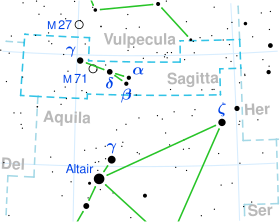 Global Information
Global InformationTheta Sagittae information
 | |
| Observation data Epoch J2000.0 Equinox J2000.0 (ICRS) | |
|---|---|
| Constellation | Sagitta |
| A | |
| Right ascension | 20h 09m 56.6470s[1] |
| Declination | +20° 54′ 54.094″[1] |
| Apparent magnitude (V) | +6.516[2] |
| B | |
| Right ascension | 20h 09m 56.2405s[3] |
| Declination | +20° 55′ 04.228″[3] |
| Apparent magnitude (V) | +8.769[2] |
| Characteristics | |
| A | |
| Spectral type | F3V[4] |
| U−B color index | −0.04[5] |
| B−V color index | +0.38[5] |
| B | |
| Spectral type | G5V[6] |
| B−V color index | +0.732[2] |
| Astrometry | |
| A | |
| Radial velocity (Rv) | −40.92[1] km/s |
| Proper motion (μ) | RA: +58.387[1] mas/yr Dec.: +98.274[1] mas/yr |
| Parallax (π) | 22.3262 ± 0.0326 mas[1] |
| Distance | 146.1 ± 0.2 ly (44.79 ± 0.07 pc) |
| Absolute magnitude (MV) | +3.24[7] |
| B | |
| Radial velocity (Rv) | −43.0[8] km/s |
| Proper motion (μ) | RA: +64.726[3] mas/yr Dec.: +101.800[3] mas/yr |
| Parallax (π) | 22.3841 ± 0.0305 mas[3] |
| Distance | 145.7 ± 0.2 ly (44.67 ± 0.06 pc) |
| Absolute magnitude (MV) | +5.58[7] |
| Details | |
| A | |
| Mass | 1.52[9] M☉ |
| Radius | 1.45[1] R☉ |
| Luminosity | 4.0[1] L☉ |
| Surface gravity (log g) | 4.32[9] cgs |
| Temperature | 6,750±229[9] K |
| Metallicity [Fe/H] | −0.17[8] dex |
| Rotational velocity (v sin i) | 33.6[10] km/s |
| Age | 2.089[9] Gyr |
| B | |
| Mass | 0.95[11] M☉ |
| Radius | 0.82[3] R☉ |
| Luminosity | 0.516[3] L☉ |
| Surface gravity (log g) | 4.526[12] cgs |
| Temperature | 5,394[3] K |
| Other designations | |
θ Sge, 17 Sge, BD+20°4453, HD 191570, WDS J20099+2055[13] | |
| A: HIP 99352, HR 7705, SAO 88276 | |
| B: HIP 99351, SAO 88275 | |
| Database references | |
| SIMBAD | A |
| B | |
Theta Sagittae (θ Sagittae) is a double star in the northern constellation of Sagitta.[14] With a combined apparent visual magnitude of +6, it is near the limit of stars that can be seen with the naked eye. According to the Bortle scale the star is visible in dark suburban/rural skies. Based upon an annual parallax shift of 22.15 mas as seen from Earth,[15] it is located roughly 147 light years from the Sun.
The binary pair consists of two stars separated by 502 AU.[16] The primary, component A,[17] is an F-type main sequence star with a stellar classification of F3V.[4] This star is about two billion years old[9] with 52% more mass than the Sun.[9] It forms a double star with a magnitude 8.85 companion,[17] which is located at an angular separation of 11.58 arc seconds along a position angle of 331.1°, as of 2011.[14] The star is sometimes described as a triple star, with a 7th magnitude companion 91″ away.[17] This is an unrelated giant star much further away than the close pair.[18] A fainter star separated by nearly 3′ was also listed as a companion by Struve,[17] again just an accidental optical association.[19]
- ^ a b c d e f g h Cite error: The named reference
Gaia-DR2was invoked but never defined (see the help page). - ^ a b c Cite error: The named reference
tycho2was invoked but never defined (see the help page). - ^ a b c d e f g h Cite error: The named reference
dr2bwas invoked but never defined (see the help page). - ^ a b Cite error: The named reference
abt1985was invoked but never defined (see the help page). - ^ a b Cite error: The named reference
hrwas invoked but never defined (see the help page). - ^ Cite error: The named reference
adams1935was invoked but never defined (see the help page). - ^ a b Cite error: The named reference
Anderson2012was invoked but never defined (see the help page). - ^ a b Cite error: The named reference
Casagrande2011was invoked but never defined (see the help page). - ^ a b c d e f Cite error: The named reference
David2015was invoked but never defined (see the help page). - ^ Cite error: The named reference
doNascimento2003was invoked but never defined (see the help page). - ^ Cite error: The named reference
ap1999was invoked but never defined (see the help page). - ^ Cite error: The named reference
mcdonald2017was invoked but never defined (see the help page). - ^ Cite error: The named reference
SIMBADwas invoked but never defined (see the help page). - ^ a b Cite error: The named reference
Mason2012was invoked but never defined (see the help page). - ^ Cite error: The named reference
vanLeeuwen2007was invoked but never defined (see the help page). - ^ Cite error: The named reference
halbwachs2012was invoked but never defined (see the help page). - ^ a b c d Cite error: The named reference
WDSC2014was invoked but never defined (see the help page). - ^ Cite error: The named reference
dr2cwas invoked but never defined (see the help page). - ^ Cite error: The named reference
dr2dwas invoked but never defined (see the help page).